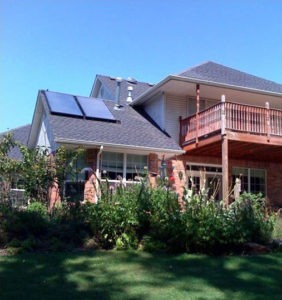Solar Hot Water Has Changed For the Better
In the realm of alternative energy and green building technologies, solar thermal (solar hot water) is not as popular as solar PV (solar electric) in America. Why?
Early Epic Fails
I believe there are a couple of reasons. The first is the perceptions that were created during the 1970s and 1980s, when there was a big trend in the US toward using solar hot water. People were excited to try and harness energy from the sun, and find natural ways to save energy. Unfortunately, a lot of the systems installed back then were poorly designed and made in China of low-quality materials, and the installation was often done by untrained technicians. Because of these problems, the overall experience left much to be desired; the systems just didn’t work right and the whole thing left a bad taste for solar hot water in the mouths of consumers. People typically ended up abandoning these dysfunctional systems, and went back to using their standard water heaters. It’s no wonder that they didn’t rush to try it again.
Current Quality Control
Since that time, however, the quality and efficiency of these systems has skyrocketed. We now have access to equipment made in places like Germany and the US, places with high levels of quality control. The systems that are being produced in America now are well-designed and the quality is something to be proud of, the kind of quality that will last for decades. Some of these manufacturers, such as SunEarth, offer specialized training too, making it possible to find knowledgeable, trained technicians. The solar thermal options available now have come a long way.
Cheaper Is Better?
The second reason, I believe, that solar thermal is not as popular as it could be, is that in some parts of America, natural gas is very cheap. People who have access to cheap energy often do not see the point in spending the extra up-front cost for solar hot water, unless they can see the significance of long term savings vs. short term cost, or they have a value for having a small carbon footprint. Just using a solar water heater can cut a household’s carbon dioxide emissions in half. A certified solar water heater will prevent 4,000 pounds of C02 from polluting the air every year—which is the same amount of C02 that would saved by not driving your car for four months! That is a different kind of savings, one that people often are not aware of, and which has value even if you do happen to have access to cheap energy.
Solar Thermal Solutions For The Rest of Us
Consumers who do not have access to natural gas are usually using either propane or electricity to heat their water, both of which can be very costly. These are the people who are typically looking for some way to cut their water heating expenses, and sometimes consider installing solar electric panels. Solar electricity is a great thing, but trying to provide electricity for your home AND your water heater will require a lot of solar electric panels. Homeowners in this situation often don’t realize that they can cut their electricity use enormously just by using a couple of solar thermal collectors for their water heating needs—and that it’s a much more efficient way to go. Solar water heaters can be cost effective because the sun’s energy is free and plentiful. Operating costs can be cut by up to 70%, and over the lifetime of a solar thermal water heater, homeowners can save thousands of dollars in energy bills. With a life expectancy of 25 years or more, a solar thermal system’s life easily beats the life expectancy of a standard tank water heater, and saves that much more. Another added bonus is that in some areas, there are sizable rebates available for those who install solar thermal water heaters. I mean, in the thousands-of-dollars kind of sizeable. It is definitely worth checking into.
Solar Water Heater Varieties
There are many types of solar hot water systems, but they are not all the same. Back in the 1970s, my wife’s uncle made a solar water heater for his hot tub using a garden hose filled with water that he kept coiled on his roof. That IS a very basic solar water system, but most are much more refined than that! For those of you with inquiring minds, I will explain the way one of the most efficient types works. It is known as an active indirect solar thermal system. You already know how much you can save on energy bills and in pollution, but once you know how it works, my hope is that you will be inspired to go ahead and give solar thermal a try.
Active Indirect Solar Thermal Systems
Most people have seen the solar panels used for electricity. Solar water heaters do not use the same photovoltaic panels, but use something called solar collectors, which look like long rectangular boxes covered with special glass that often sit up on rooftops. (See diagram, courtesy of SunEarth) Inside the box, there is a copper manifold filled with a glycol/water mixture. Once hot, the glycol mixture is pumped from the solar collector to the storage tank, where it transfers its heat to the plain water in the tank through a heat exchanger (a simple device that keeps the fluids separated to prevent mixing), and then circulates back to the roof to collect more heat. The glycol/water mixture never touches the water inside the tank, but only passes heat to it. The hot water storage tank is usually quite large (80-100 gallons), so it can retain most of the heat from the day through the night or cloudy times. Where the hot water comes out of the tank, there is a tempering valve which mixes additional cold water with the hot water coming out to keep it at a safe temperature, since solar-heated water can easily reach 180°F!
Note: this also means that if you have a solar water heater, you have a ton of hot water. Because of the added cold water, you have access to considerably more hot water than the size of the tank, which is already twice as big as a standard tank!
After the water leaves the storage tank, it is piped through a back-up water heater, which only turns on when solar heat is not available and the water in the tank drops below a certain temperature. With solar hot water heater, you always have all the hot water you need, and MUCH lower energy costs too.
A Variety of Solar Systems
There are so many different types of solar thermal systems. Whether you live in a hot, sunny area, or you are in a colder mountain climate, there is one to suit your needs. From commercial buildings, to a large home with lots of people, a small cabin that you go to for short vacations, or a swimming pool that is too cold to use most of the year, solar water heating can be your solution, wherever you are. There is even a solar thermal water heater installed at the White House to heat the pool and spa. I have a friend who has a dream of having a small steam engine on his property—it is even possible to generate steam using only solar thermal! It can be used to heat your household water, radiant flooring, hot tub, space heating for green houses, or in my friend’s case, create steam. The possibilities are amazing.
Wherever you are, if you are looking for an environmentally sustainable answer, you can’t get more green than solar. It’s (thankfully) not what it used to be.
If you are interested in installing a solar thermal hot water heater for your house or pool, or have any questions, please give us a call. We’d love to help you find a solution for your Asheville solar hot water needs.


